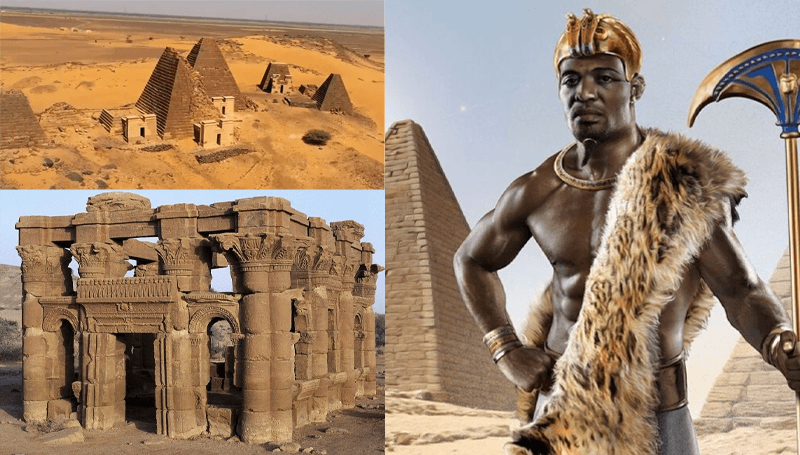Archaeological discoveries and historical documents indicate that the ancient city of Meroe served as the capital of the kingdom of Kush, which is now located in Sudan.
Kush was a northern African kingdom whose influence spanned approximately 1069 BCE to 350 CE. Although the region around Kush, later known as Nubia, had been inhabited since around 8,000 BCE, the kingdom of Kush rose later. Findings also indicate that, while early Egyptians and the Kushite were in contact as early as c. 3150 – c. 2613 BCE during Egypt’s Early Dynasty Period, the Kushite civilization most likely evolved from this early cultural contact and was heavily influenced by the Egyptians.
Kush, which was rich in gold, was the Egyptians’ main source of this precious commodity, and it is widely assumed that the later name, Nubia, was derived from the Egyptian word for gold, ‘nub.’ Because of the Kushite kingdom’s vast wealth, it quickly ruled over Egypt and dominated its politics, with its kings ruling over Egypt.
Egypt’s weakness benefited Kush, and Kushite kings reigned without reference to Egyptian monarchs or policies around 1069 BCE. As the kingdom expanded steadily, it reached the point where it could take whatever it wanted from Egypt without deferring to Egyptian kings. They rose to power in Egypt over time, not to conquer, but to preserve Egyptian culture and heritage.
Meroe, the Great City
He was succeeded by a puppet king named Necho 1 after the 25th Dynasty ended with Tantamani. His son, Psammetcus 1, also known as Psamtik 1, c. 665-610 BCE, ended Assyrian rule and established Egypt’s 26th Dynasty. Psammeticus and his successor, Necho 11, ruled successfully. Nonetheless, Psammeticus 11, Necho 11’s successor, led an expedition against Kush, destroying towns, temples, monuments, stele, and finally the capital city of Napata before calling it quits and returning to Egypt due to boredom.
For safety reasons, the capital city of the Kushite kingdom was relocated further south to the town of Meroe around 590 BCE. Meroe’s rulers continued to imitate Egyptian customs and fashion, as well as Egyptian policies and religious rituals, until the reign of King Arkamani.
Arkamani 1 had some education in Greek philosophy and resisted being controlled by priestly superstitions, according to historian DIodorus Sirculus (1st century BCE). As a result, he led a band of men to the temple, slaughtered all the priests, and ended their reign over the monarchy. In their place, he implemented a new policy and practice that included abandoning Egyptian cultural practices in favor of Kushite practices.
Arkamani, for example, replaced Egyptian hieroglyphic script with Meroitic, which has yet to be deciphered. He also changed the fashion sense from Egyptian to Meroitic, and Egyptian gods such as Aperdemak were assimilated into Kushite ones. Burial customs were also altered, with royalty now buried in Meroe rather than Napata, where they had previously been interred.
Meroe, on the Nile’s banks, thus became the capital of the Kingdom of Kush. Its ironwork and trade brought it great wealth as an agricultural and industrial center. Agricultural products such as grains and cereals were exported, as were iron weapons and tools, and the city was overrun with livestock.
Meroe became legendary, and King Cambyses 11 of Persia (525-522) is said to have launched an unsuccessful expedition to plunder. If the expedition was ever launched, legend has it that Cambyses 11’s army was defeated by the treacherous and inhospitable terrain they crossed, as well as the weather.
The Axumites, however, invaded and sacked Meroe around 330 CE. Even though the city will survive for another 20 years, it has been effectively destroyed. Meroe was doomed even before the invasion and would have imploded. For one thing, the iron industry required a large amount of wood to produce charcoal and fuel the furnaces used in iron smelting. Because of the high demand, a large portion of the city has been deforested. Furthermore, due to the city’s large livestock population, the fields around the city were heavily overgrazed and overused for crop production, depleting the soil.
Meroe was already in decline and on the verge of abandonment before the Axumites arrived. The once prosperous and wealthy Kingdom of Kush had effectively come to an end by the time the last of the people walked away from the city around 350 CE.
 The African History Truly African
The African History Truly African

